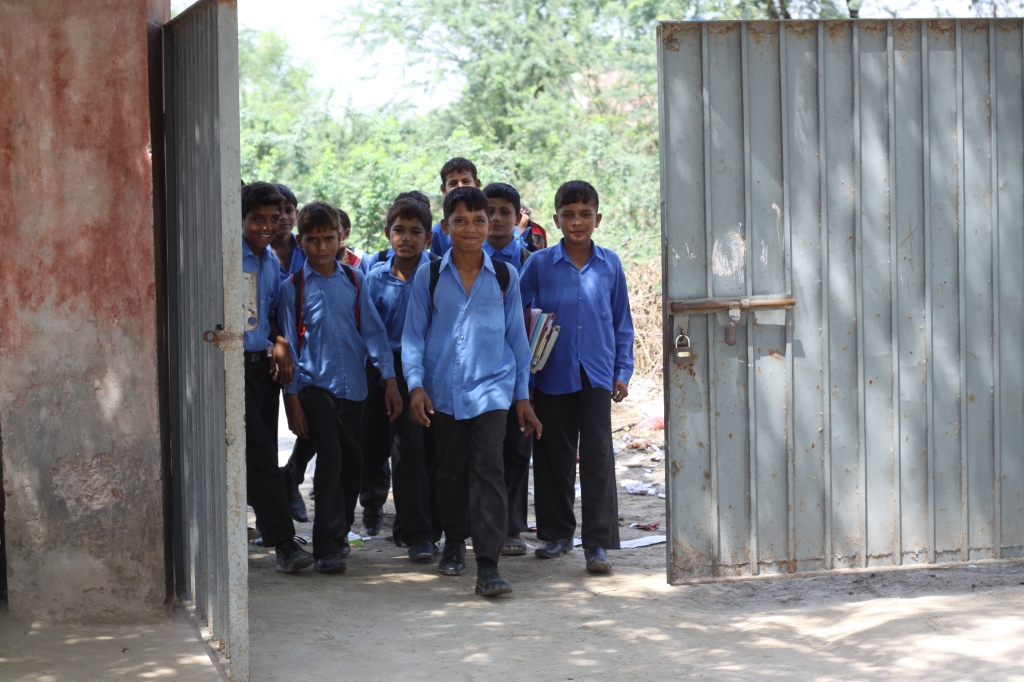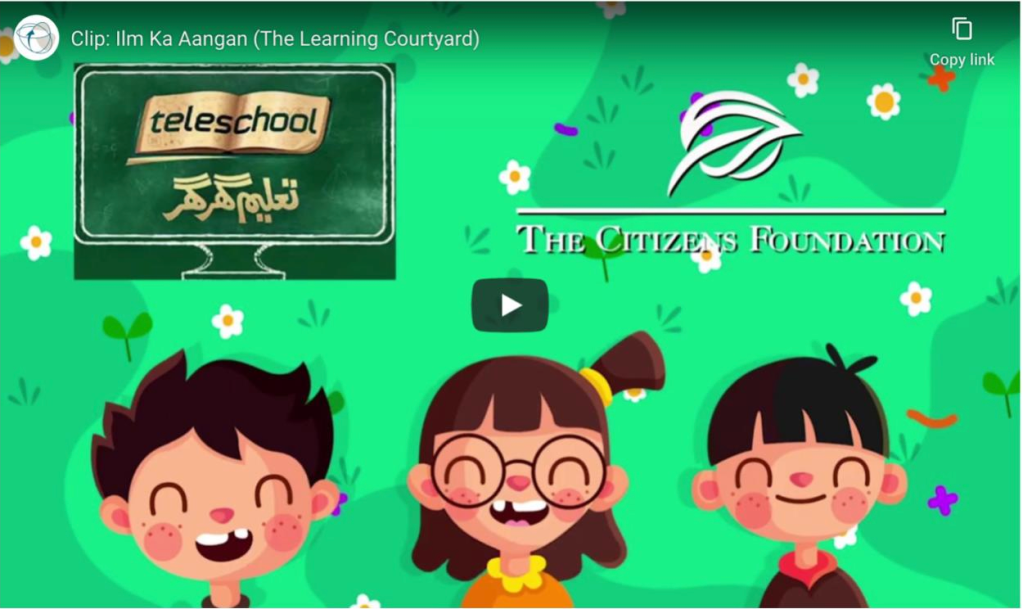This week’s post features an e-mail interview with Neha Raheel, (@NehaRaheel), Manager, Learning Experience & Assessment Design, Partnership Schools, at The Citizens Foundation (TCF) in Pakistan. Neha was also recently selected as a WISE Emerging Leader for her work at TCF. As described in an IEN post in 2019, TCF was launched by six friends in Karachi Pakistan who saw education as a key to addressing a wide range of social problems. Since establishing five new schools in 1996, TCF has developed a network of over 1600 schools in Pakistan.
This post is the sixth in a series that includes views from Chile, from Japan, from the Netherlands, from Scotland, and from Liberia. The “A view from…” series editors are IEN’s Thomas Hatch and Karen Edge, Reader/Associate Professor in Educational Leadership at University College London’s Institute of Education.
IEN: What’s happening with you, your family/friends, and co-workers?
Neha Raheel: The lockdown in Sindh (one of Pakistan’s provinces, located in the southeastern part of the country), where I currently live and work, was announced on March 23rd, 2020 (initially for a period of 15 days, which extended till early June). The government began to lift the lockdown gradually in the first week of June, despite the number of cases being on the rise. Currently, education institutions, marriage halls, beauty parlors, cinemas, etc. remain closed while businesses have been allowed to operate between the hours of 06:00 am – 7:00 pm (five days a week) in certain parts of the country. The government also began putting several localities under “smart lockdowns” as the number of cases was surging. However, some of these localities have now started to re-open, and the government has announced that it will be making a decision regarding the re-opening of government schools and educational institutions on July 2nd.

TCF, as an organization, had announced that at the discretion of the Heads of individual departments, we were allowed to begin working from home from March 16th onwards, so my colleagues and I have been doing so since then. My team and I work on curriculum and assessment design for TCF’s Public-Private Partnership schools (340+ schools adopted by the organization from the governments of Sindh and Punjab, with a mandate to improve access to, and quality of education).
Work from home has presented a whole host of challenges for us. We started this project by working with a team of content developers: part-time employees whose main task was to help us create lesson plans for the Teacher Guides that we are currently designing for our Partnership schools (a majority of our Partnership contracts mandate us to use the government’s syllabus, instead of the one designed by TCF for its flagship schools). These content developers do not always have access to technology (they create handwritten content for us, which is then typed at the Head Office). The quality of the lesson plans has always been heavily reliant on feedback; which pre-COVID, was given and discussed in weekly in-person meetings. Since these meetings can no longer take place in person due to the lockdown, we have been struggling with shifting the feedback sessions to take place over phone calls (a lot of people who work part-time with us do not have access to a laptop/computer or a stable internet connection at home). We also had a lot of drop-outs from the project because the women that we work with simply could not cope with the demands of managing their caregiver duties with a part-time project. As a result, we had to innovate and come up with an alternate recruitment and onboarding strategy. We are now relying heavily on the grace and magnanimity of a team of volunteers who graciously have agreed to assist us with our work on various projects (1100+ people have applied to volunteer with our department in the past month, alone). We are still grappling with the task of working remotely, not only within the team, but also with our volunteers.
IEN: What’s happening in the communities where you work?
NR: Especially where our Partnership schools are housed, TCF works within communities with some of the lowest average incomes in the country and, as such, the digital divide has prevented us from using traditional education technology-based solutions for distance learning. TCF has, instead, been working on creating multi-grade content for a national TV channel: creating a televised show that focuses on student wellbeing (including physical movement through the yoga/exercise section of the program), joy, and basic literacy and numeracy skills (storytelling section and guided activities/assignments). Students also send in their artwork and assignments to TCF in response to the content broadcast in the program. TCF is also piloting a magazine to assess the effectiveness of paper-based Self Study Materials. The aim is to try to be as inclusive as possible and to try to reach as many students as we possibly can, especially those who are most impacted by the digital divide and learning losses.
At the same time, we are also thinking ahead to what will happen when schools eventually reopen. As such, my team’s biggest project this year is creating Teacher Guides for our Partnership Schools, with the purposes of improving the quality of teaching and learning activities in what are often rote learning based and teacher-centered classrooms; to reduce teacher workload of lesson planning (the majority of our teachers spend the entire day in the classroom, teaching all subjects and, as such, do not find time to research and create learner-centered lesson plans); and to serve as a developmental tool, building teacher capacity. These Teacher Guides are being made for the post-pandemic/post-lockdown world that our teachers and students will return to. The trauma-informed approach to education tells us about the importance of bringing joy, safety, trust, and hope in the lives of learners who have been through a trauma. As our students deal with potential losses of life, learning, and/or livelihood, our focus has primarily been on designing interventions keeping the principles of teacher and student wellbeing at the front and center: we are thinking deeply about how to restore stability, joy, hope, and trust in their lives, while being cognizant of the large learning losses that most of our students will likely face. The curriculum in these Guides, along with the restructuring of the school day, will allow us to include engaging learner centered activities, brain breaks and movement-based activities (to energize students, provide them with processing time, and bring a sense of joy in their lives); opportunities for guided and free play, and meditation and mindfulness activities. We are also mindful of the loss of connection, anxiety, and stresses that students might face in their absence from school (which is more often than not a safe and joyous space for our kids) and we hope that classroom routines such as mindfulness, meditation, yoga, play, storytelling, collaborative pair/group work, gratitude journaling, and understanding, acknowledging, and knowing how to express one’s feelings will restore that sense of connectedness and will bring back joy and hope in the lives of our students when they return to school.
As our students deal with potential losses of life, learning, and/or livelihood, our focus has primarily been on designing interventions keeping the principles of teacher and student wellbeing at the front and center: we are thinking deeply about how to restore stability, joy, hope, and trust in their lives, while being cognizant of the large learning losses that most of our students will likely face.
IEN: What do you/your community need help with?
NR: The digital divide is becoming increasingly tied with learning losses and is likely to result in a widening of the already prevalent achievement gaps in our country. At the policy level, we need to think about ways of lessening the impact of the digital divide on student learning (perhaps beginning with a drive of providing students/communities with access to electricity/basic tech/internet). At the same time, we are drawing our inspiration from several innovative (and low/no cost resource based) initiatives, such as the remote learning work being done by Pratham, India and Teach for Pakistan’s WhatsApp school. TCF is a not-for-profit and, as such, relies heavily on the philanthropic donations of people from across the world. To be able to continue fighting the good fight, we need people to keep donating for the cause, and also (if possible) volunteer their expertise for the various programs that we have. TCF is also actively thinking about the potential increase in drop-out rates once schools open (as evidenced by the drop-outs following the Ebola crisis), especially with relation to the gendered nature of the drop-outs. A question that we are currently thinking deeply about is: How can we re-engage students whose parents might find an extra set of earning hands to be more useful than continuing their education? As we continue working on our television program and pilot our magazine, we would appreciate any and all advice/resources/connections that would help us create, curate, and disseminate content.
IEN: What resources/links/supports have you found most useful?
NR: There are several websites that are providing their content/lesson plans/lesson activities free of charge, including but not limited to the following:
- Learning Activities and Play Ideas for Pre-K-II:
a. Pre-Kinders
b. Play Ideas
c. Steamsational
d. DREME TE (Math activities for early years) - Lesson Plans/Unit Plans (for all grades):
a. National Geographic Education
b. Teachnology
c. PBS Learning Media (also includes videos)
d. The Teacher’s Corner
e. Scholastic
f. Harvard Graduate School of Education’s Virtual School Lesson Plan Database - Stories
a. Storyweaver
b. Bookdash
c. Global Digital Library - Mindfulness/Meditation Exercises
a. Kids Relaxation
b. Mindful Teachers
c. Teach Starter
IEN: What are you reading, watching, listening to that you would recommend to others?
NR: Twitter has been a great source of connecting with educators from across the globe and has allowed me to watch/read/listen to the ways in which educators are responding to the crisis. Some of the accounts that I have found to be most useful include, but are not limited to: Teaching Tolerance, Social Emotional Learning, WISE, Design for Change, Pratham Education Foundation, Rising Academies, Math and Movement, CASEL, Recipes for Wellbeing, Karanga, SELinEdu, and many more. Webinars and conferences, so many of which have become freely available, have also been a great source of information (e.g. WISE Words, the T4 Education Conference, RISE Webinars, Catalyst 2030; Karanga’s Global SEL Conference, Education Disrupted, Education Reimagined, Elevating Education in Emergencies: Securing Uninterrupted Learning for Crisis-affected Children, etc.).

IEN: What have you found most inspiring?
NR: Videos/comments/thoughts from TCF school leaders and teachers have allowed me to stay connected with the communities where we work and have also inspired me with their messages of resilience, hope, gratitude, and positivity. Reading about stories of inspiring teachers from different parts of the world has been an additional source of inspiration. Doing a daily virtual gratitude journal with my team members has brought several moments of positivity and gratitude to my life: reading each other’s responses and thoughts about simple and positive moments brings smiles to all of our faces. Playing games (including a Harry Potter themed escape room) and doing mindfulness check-ins with my team as we all navigate work from home and feelings of isolation and anxiety/uncertainty has been both grounding, as well as inspiring, as we all try to collectively navigate the new reality. More so than anything else, my dog (we rescued her a few months prior to the pandemic): the amount of joy and hope that she brings in my life is unparalleled.

Pingback: My View from Ottawa, Ontario, Canada: Trista Hollweck on School Closures and the Pandemic | International Education News
Pingback: A View of School Closures and Remote Learning From Emma Hua in Shanghai | International Education News
Pingback: Disruption and Rapid Response: A View of School Closures in Uganda From Educate! | International Education News